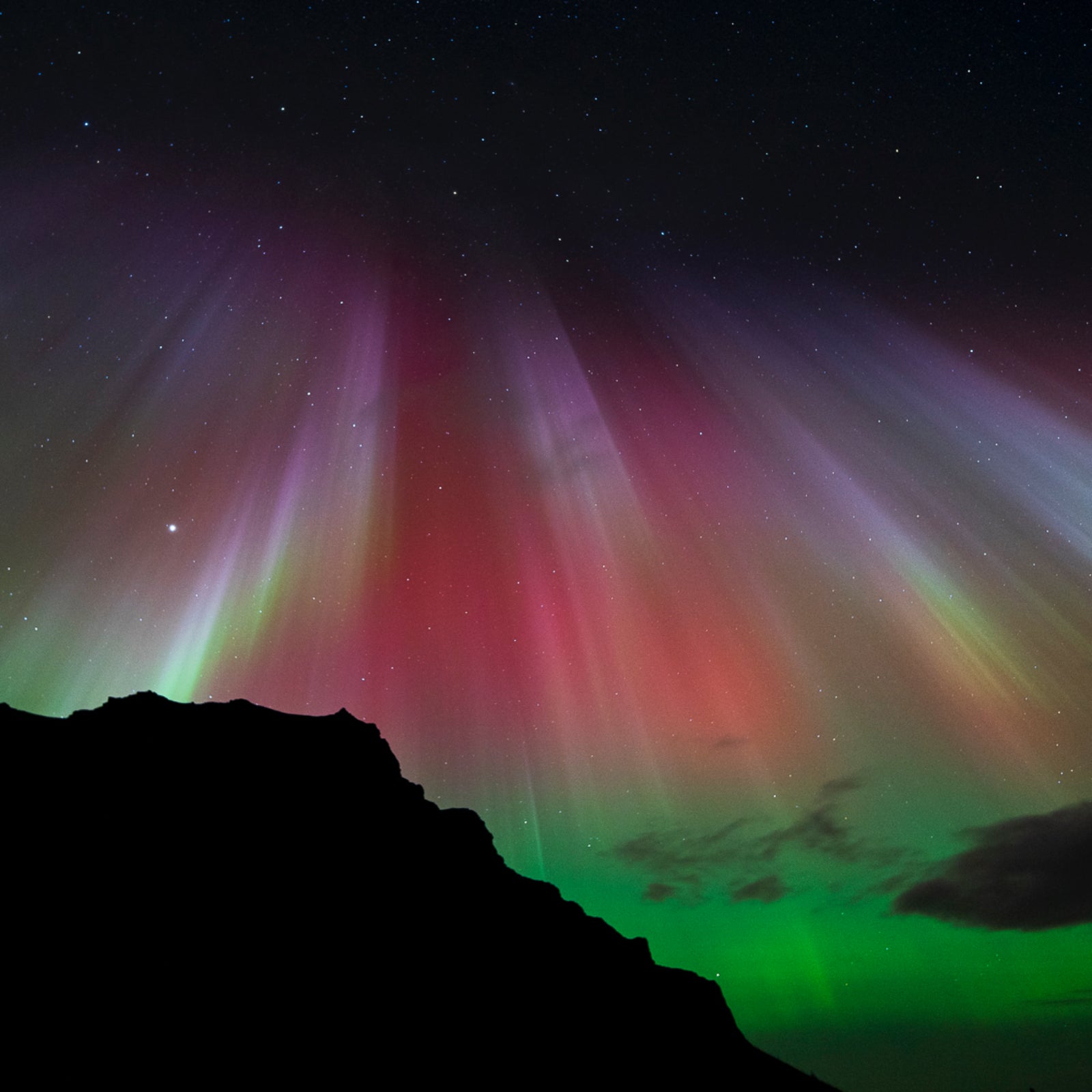Eight hours into an incredible show of jaw-dropping northern lights, the fatigue started to hit. What began as a calm evening—me and the resident sheepdogs of the Ilungujuuk Hostel admiring the last sunset of my solo trip through south Greenland—had morphed into an all-night aurora borealis bonanza that kept me on my feet, my eyes on the sky.
I raced around the property grounds working my two tripods, hoping to photograph every shifting iteration of the intensifying lights: violet, lime, and cobalt ribbons reflecting off the fjord waters, an explosion of green tie-dye above the adjacent farm, and an eerie red glow enveloping the mountains I’d just hiked. By the time I finally looked at my phone, it was 4:30 A.M.—I was exhausted, but it was worth it.
For years I’ve chased auroras around the world, from Norway to Michigan, and have 50-plus successful sky-swirl nights beneath my belt—including a string of seven kaleidoscopic nights of auroras in Greenland before my Ilungujuuk stay. Yet this particular night in September 2023 was different. The colorful pillars danced and pulsed, then flickered overhead like lightning, electrifying the heavens from dusk to dawn. It was the most surreal display I’ve ever seen.
But in 2024, experts predict the northern lights will get even wilder.
Get Ready for a Spike in Auroral Activity
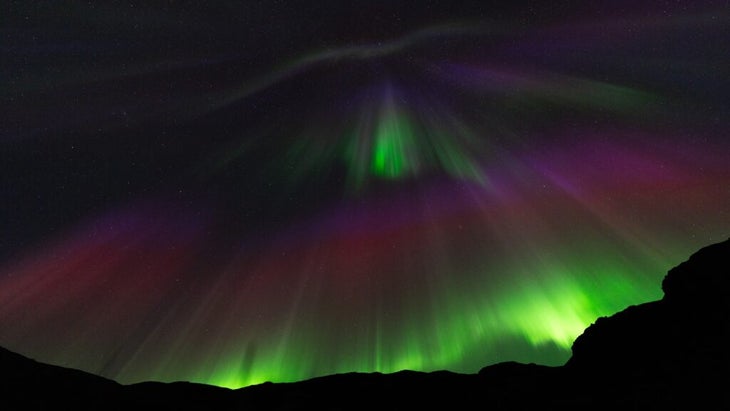
Auroras are generated when storms on the sun’s surface blast particle-packed winds through the solar system. Although earth’s magnetic field protects us from most solar winds, some particles sneak through, and as they slam into our atmosphere, they create the crayon box of colors I saw in Greenland. Each hue is caused by a different interaction with gases—green (the most common) from oxygen, blues and purples from nitrogen, and red (rarely seen) from less concentrated oxygen at higher altitudes. During strong displays, the lights can mix like paint, creating pink, yellow, and orange pillars.
Last year’s auroral colors were a mere preview of what’s to come. Over the next ten months, the intensity and frequency of solar storms are expected to peak—a period that happens roughly every 11 years known as solar maximum. According to the National Oceanic and Atmospheric Administration, between now and October, Solar Cycle 25 (which began in 2019 and will run until 2030) could produce the strongest and most dazzling aurora displays we’ve seen in decades.
That means there’s no time like the present to make your bucket-list aurora trip a reality. I’ve compiled some of the best and most geographically diverse spots to see brilliant displays of both the northern and southern lights, along with details on how to chase them, where to stay, and unique tours that take in the lights. All of these destinations lie within, or just outside, the auroral oval—a doughnut-shape ring above the geomagnetic north and south poles where more activity happens. Which is exactly what you want.
The Best Places to See the Northern Lights
South Greenland

Located within the auroral oval, south Greenland sees little to no light pollution, and its saw-toothed peaks and iceberg-filled fjords make for incredible silhouettes against the glow. The best time to view the lights dancing here is from late August to April (though the spectacle technically still happens outside of those months, you won’t see them in the summer due to the midnight sun in Greenland, and the rest of the Arctic). Fly into Narsarsuaq Airport via Reykjavík, Iceland, or Copenhagen, Denmark, then head to the region’s largest town, Qaqortoq (population 3,000) for a guided chase with Pink Peak Tours, run by two Inuit sisters. I recommend hiking the blaze-marked paths and gravel roads up into the mountains, home to among herds of sheep, before heading back to your base at a farm property, like Illunnguujuk (from $53), to enjoy the Lite Brite nightscapes.
Lofoten Islands, Norway
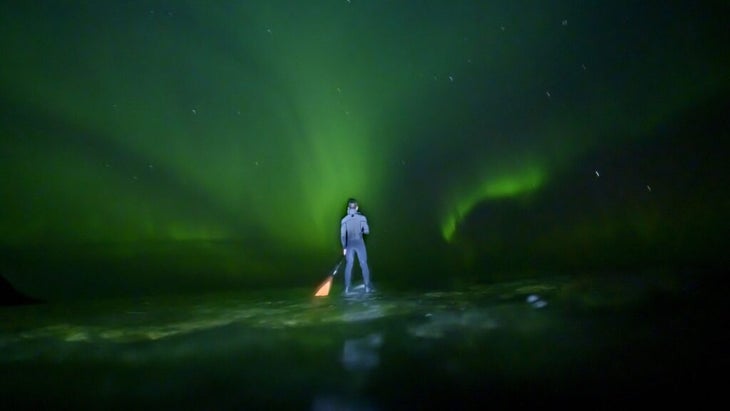
The ice-carved fjords and jagged peaks of Norway’s Lofoten Islands are also smack-dab within the auroral oval. The archipelago is a popular summer destination for hiking, climbing, and fishing, but the spectacular auroras happen, thankfully, in the off-season months after the crowds have gone home. For a particularly unique Lofoten experience, go aurora-hunting via horseback on a sandy (or snow-dusted) beach with outfitter Hov Gård, sail beneath the spectacle with Pukka Travels, or book a night in one of the historic Eliassen Rorbuer fishing cottages (from $154) to watch the green lights sashay over the sea—something that the cottages boast is possible more than 180 days a year.
Northwest Territories, Canada
Weather permitting, you can watch the northern lights in the Northwest Territories up to 240 nights annually, according to this northern province’s tourism board. With tundra and spruce and birch forests, as well as Canada’s largest reindeer herd, this destination provides quite the backdrop. See the show by dogsled with North of 60 Aurora Adventures, an Indigenous-run and family-owned business based in Yellowknife. Or head to nearby Aurora Village for an evening tour complete with cultural storytelling and a stay in a cozy lakeside tepee (hotel packages available from $527 for two nights). For even more of a treat, travel above the Arctic Circle to Inuvik for a four-day Finisterra Travel trip, replete with reindeer-watching, snowmobiling, and aurora hunting ($4,395).
Iceland
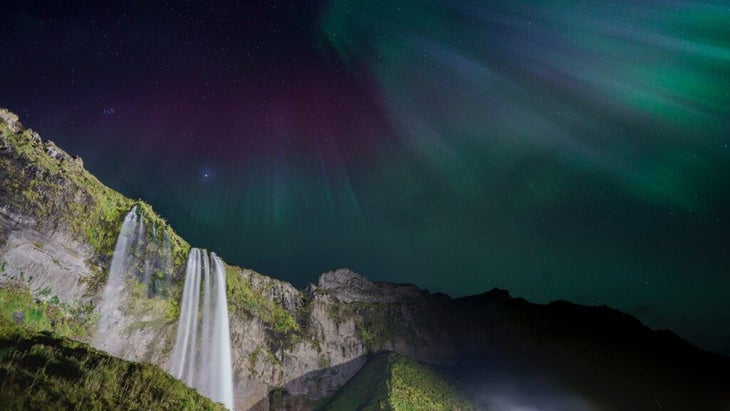
I tell many first-time aurora hunters to try Iceland. It’s easily reached, very navigable, daytime adventures abound, and, thanks to minimal light pollution, you can spot the streaks just about everywhere—I’ve seen them above waterfalls, beaches, and even over the capital city of Reykjavík. But my favorite Iceland aurora perch is a hot spring. You’ll find naturally heated pools (known as hot pots), all over the country. I like the Miðhraun Lava Resort (from $283), a collection of cabins with a central soaking pool on the Snaefellsnes peninsula, home to Kirkjufell, a small mountain shaped like a sorcerer’s hat that makes for a strenuous but rewarding hike. Aurora chasing at Heydalur guesthouse (from $110) in the untamed Westfjords is another one of my favorites. You can soak beneath the aurora swirls or enjoy the lights among its resident horses.
Fairbanks, Alaska

For U.S.-based aurora hunting, it’s tough to top the boreal forest surrounding Fairbanks, which promises impressive northern-lights odds. Explore Fairbanks says that anyone who hunts for the spectacle for at least three nights during the August-to-April aurora season has a 90 percent chance of success. The local First Alaska Tours offers a dinner and dogsled experience that takes in the nightly auroras, or drive two hours south to mush in Denali’s shadow with Denali Dog Sled. For a snowshoe adventure beneath the lights, the Fairbanks outfitter Aurora Bear offers trips along six miles of trails north of town. And an hour east of Fairbanks, aurora hunting from the Chena Hot Springs Resort is a popular pick—you can soak from a geothermal pool while the colorful lights riot above (from $180).
Abisko National Park, Swedish Lapland
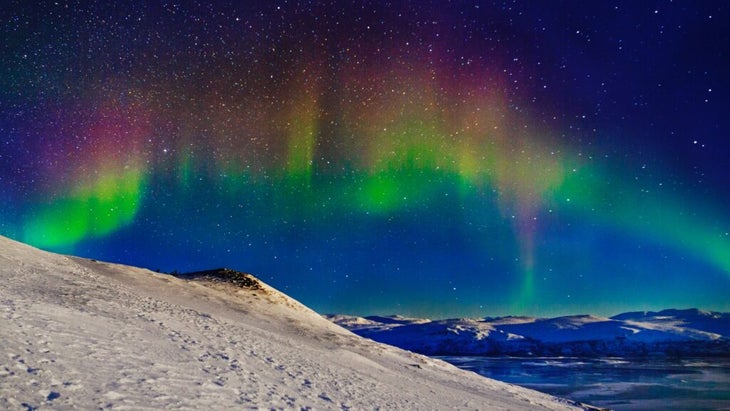
A unique weather phenomenon makes Abisko National Park one of the world’s top aurora-hunting locales. While the northern lights are active throughout the auroral oval most nights, weather—particularly cloud cover—determines if chasers will see them or not. That’s where Abisko’s “blue hole” comes into play: according to the BBC, a stretch of sky above the park stays clear regardless of the surrounding conditions, something attributed to wind direction and altitude. You can make the most of this meteorological marvel at the park’s Aurora Sky Station, a viewing center set at 3,000 feet elevation and accessed via a 1.2-mile-long chairlift. Come for the lights, but stay for the station’s multicourse Swedish dinner, where glass ceilings let you enjoy a taste of Lapland without missing the night-sky entertainment. The best time for lights chasing in this area is mid-November to mid-March.
Northern Minnesota
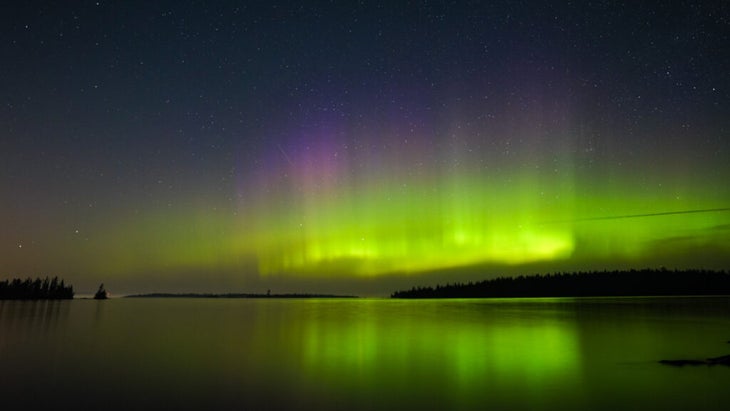
While many of the best northern lights destinations sit within the auroral oval, you don’t have to travel to the ends of the earth—or even out of the contiguous U.S.—to see them. In fact, you can enjoy them from many national parks. The auroral oval’s path tilts particularly in favor of Great Lakes escapes like northern Minnesota, but to see the aurora this far south, you’ll need a strong solar storm, minimal light pollution, and a clear view to the northern horizon (like a lake) because the distance will make the lights appear closer to the horizon. I suggest scouting from the lake-abundant Voyageurs National Park or the wilds of Boundary Waters Canoe Area Wilderness—both were recognized by DarkSky International as outstanding dark-sky spaces. To keep tabs on aurora activity and get involved with locals in the know, join the Facebook group Great Lakes Aurora Hunters, whose members share updates on the northern lights regularly.
The Best Places to See the Southern Lights
Stewart Island, New Zealand

The aurora borealis gets all the buzz, but the Southern Hemisphere’s aurora australis—better known as the southern lights—are worth chasing, too. For that, head to Stewart Island, which earned DarkSky International’s Dark Sky Sanctuary status in 2019. More than 85 percent of the island, located 16 miles south of the South Island and accessed via an hourlong ferry, is a national park, with 170 miles of hiking trails, including the Rakiura Track, one of New Zealand’s Great Walks, making this one of the more adventurous ways to enjoy the lights. Like Minnesota, Stewart Island isn’t usually in the auroral oval, which means you’ll need a strong solar storm to see any activity here. Unlike Minnesota, you’ll have to look southward to spot them.
Tasmania, Australia
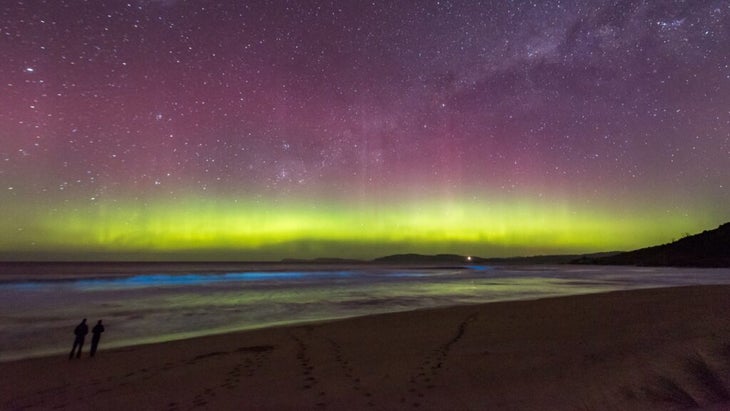
Tasmania is another hub for aurora australis hunters. Margaret Sonnemann, author of The Aurora Chaser’s Handbook, says this island state is better positioned for sightings than just about anywhere in the Southern Hemisphere outside of Antarctica (which is nearly unreachable for tourists during aurora season). Its rugged peaks, ancient rainforests, and sandy shores only add to the auroral awe. Since Tasmania, like Stewart Island, doesn’t experience the midnight sun, the aurora is visible year-round—pending the weather, of course. Popular sky-watching spots include Goat Bluff lookout and Carlton Beach, or book a stay at Pedder Wilderness Lodge (from $93), a lakeside base for rainforest bushwalks by day and celestial gazing at night. You can also have an awesome experience at Taroona Beach, admiring two twilight marvels—auroras and bioluminescence—during the warm summer months.
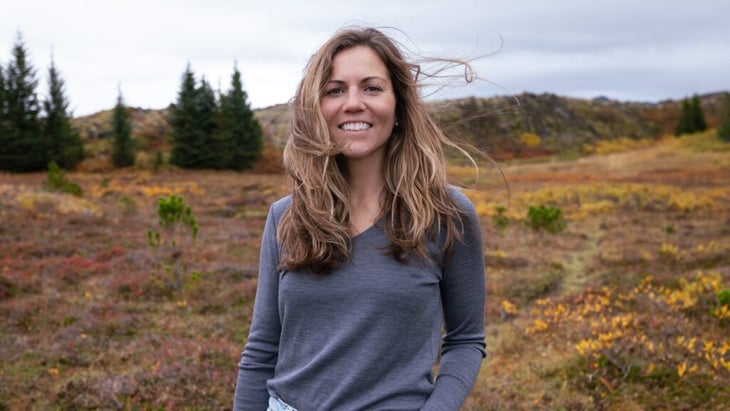
Journalist and photographer Stephanie Vermillion covers adventure travel and all things astrotourism, from eclipse chasing and meteor showers to her personal obsession: auroras. She hopes to check off another astro-bucket-list topper—seeing the southern lights—during a trip to New Zealand’s South Island this year.
Want more of Outside’s award-winning travel coverage? Sign up for our Destinations newsletter.

